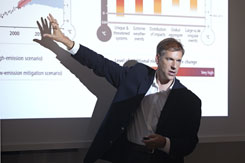Oct 24 2014
Multiple pathways exist to a low greenhouse gas future, all involving increased efficiency and a dramatic shift in energy supply away from fossil fuels. A new tool 'SWITCH' enables policymakers and planners to assess the economic and environmental implications of different energy scenarios. It is presented today at the congress Global Challenges: Achieving Sustainability, hosted by the University of Copenhagen.
 Professor Daniel Kammen. Photo credit: Lizette Kabré.
Professor Daniel Kammen. Photo credit: Lizette Kabré.
"SWITCH is a tool we can use to examine the different choices of technologies within the electrical power sector and their locations. It enables us to estimate the impact on regional air pollution emissions, as well as how much land area and water consumption would be needed for each scenario. We have used this model for different future energy scenarios across western North America, and we see an enormous variation in both the magnitude and location of environmental impacts," explains doctoral candidate Tessa Beach. She is presenting the tool today together with Professor Daniel Kammen, Director of Renewable and Appropriate Energy Laboratory, both from the University of California, Berkeley.
The tool demonstrates that different energy scenarios with the same decarbonisation target can make a difference of 108.000 tons in annual air pollutant emissions or 1.2 million acres of land use; an area about twice the size as the country Luxembourg.
While Tessa Beach presents results today for the interconnected grid system that spans the western United States, Alberta, British Columbia and northwest Mexico, Daniel Kammen notes that his laboratory has also developed versions of SWITCH for China, Chile, Nicaragua, and hopes to next release versions for Mexico, India, and East Africa.
"With this tool we can examine not only carbon emissions, but also those of other greenhouse gases, and as a result tease apart the cost-effectiveness of the scenarios as well as identify what and where impacts are likely to occur for a range of resources," says Daniel Kammen.
Scenarios in the model reflect different economic and policy options that would influence e.g. natural gas prices, hydropower availability or cost of solar power.
Need to move beyond a sole focus on carbon reductions
The notion that carbon reduction targets should not stand alone, is backed by Alexis Laurent from the Technical University of Denmark, who is presenting related results at the congress today. He has shown that carbon emission generally is a poor metric for overall environmental impact:
'We know that carbon footprint, a popular indicator used in environmental policies, does not correspond well with other environmental impacts such as toxicity to ecosystems and humans, depletion of resources, and land use. In a decision-making context where you are confronted with product A and product B with the same carbon footprint score, you do not have enough information to choose the most environmentally friendly option", says Alexis Laurent from the Technical University of Denmark.
Ignorance of this risk might, e.g. through suboptimisations in technology developments, undermine the global efforts to move toward a more environmentally sustainable society. Alexis Laurent does however highlight carbon footprinting as a useful first step towards a more detailed full life cycle analysis, when you wish to assess sustainability of products or services.
The researchers call for a need to move beyond a sole focus on mitigating the effects of climate change to reach solutions that consider global carbon reduction targets as well as local energy and environmental contexts.
"Decision makers can use the SWITCH tool to examine and anticipate the potential local environmental impacts associated with technology pathways in their regions. The high spatial and temporal resolution of the SWITCH model permits an assessment of the energy generation, resource demands, and greenhouse gas emissions that come with different mixes of energy generation and distribution choices" says Daniel Kammen.